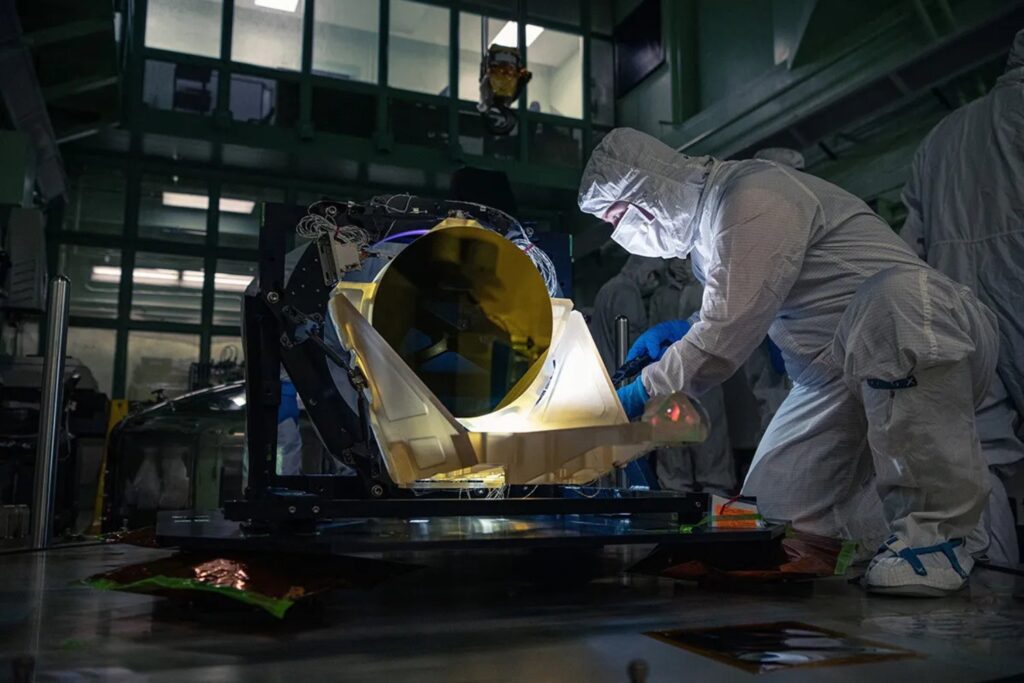LISA, a $1.6 billion gravitational wave observatory set to launch next decade, will revolutionize the way we see gravitational waves—the infinitesimal perturbations of spacetime first predicted over a century ago and only detected eight years ago.
In the fall, we published a deep-dive into LISA’s design and the engineering hurdles that must be overcome to get the futuristic craft into space. Now, we’ve asked scientists about the actual data LISA will collect—what insights that data could yield and how those insights stand to change our understanding of the universe, from the sources of its gravitational ripples to the way those reverberations shape the cosmos.
LISA: Simple yet precise
LISA stands for the Laser Interferometer Space Antenna, and comprises three spacecraft orbiting the Sun in a fixed triangular formation. LISA is an interferometer, meaning that the mission will sniff out gravitational waves using laser interferometry—measuring the distances between masses using incredibly precise laser beams about 5 million miles (8 million kilometers) long, with each arm of LISA’s triangle comprising about 1.6 million miles (2.5 million km) of that length.
The lasers are crucial but only one part of LISA’s design—they’re just the measuring sticks for distances between three metal cubes, one in each of the three LISA spacecraft. The cubes are made of a gold-platinum alloy to minimize the magnetism that could act on them. Again, the goal of LISA is to cruise through space with positively nothing touching these cubes but spacetime and the gravitational ripples that ride on it.
“The basic idea behind the design is that we’re launching these cubes,” said Saavik Ford, an astrophysicist at the American Museum of Natural History, in a call with Gizmodo. “We just want them to sit there and experience the joy of spacetime with no other forces acting on them, and it’s that last part that’s the hard part.”
“You need to maneuver the craft as the masses [the gold-platinum cubes] are falling, to make sure the spacecraft itself doesn’t drift into the masses and whack them, which would be terrible,” Ford added.
As far as grasping the complexity of LISA, Ford’s then-graduate student Jake Postiglione has an analogy: The technical challenge is akin to firing a laser from New York to LA (if the Earth was flat), and trying to hit a fruit fly’s eyeball with it. And both the laser and the fruit fly are moving as that operation unfolds.
The scale of the engineering challenge is “frankly mind-blowing,” Ford said, “and I am so glad that it is not my department.”
NASA is providing several elements of LISA’s instrumentation, including its laser system, telescope systems, and the devices that will manage levels of electric charge on the test cubes.

The frequency of orbiting objects is determined by how often they complete a full orbit around each other. Our gravitational wave detectors are good at detecting certain frequencies for a variety of reasons, but every existing detector has one major limitation: They’re stuck on Earth.
A space-based oracle for ancient black holes
Gravitational wave detectors vary in the types of orbital frequencies they detect. Ground-based detectors—namely the LIGO-Virgo-KAGRA Collaboration—are great at detecting high frequencies, which correspond to smaller masses like black holes the size of stars. But when those masses get a little larger—say, more than two hundred times the mass of our Sun—their orbital frequencies are a similar range to the noise produced by our own planet.
“There is basically a frequency where the Earth itself is just so noisy that the ground is your problem,” Ford said. “You literally can’t do it. You have to go to space, one way or another.”
In space, pulsar timing arrays make for a useful measuring stick for the largest black holes, though Earth is still part of the equation. In that setup, observatories on Earth monitor the reliable flashes of light from rapidly spinning objects (pulsars); when the timing of that light to Earth is slightly delayed or hastened, it’s an indication that spacetime was stretched or compressed by gravitational waves. In 2023, a group of pulsar timing array collaborations found strong evidence of a gravitational wave background in pulsar data.
The black holes seen by pulsar timing arrays are typically billions of times the mass of the Sun and reside at the center of monster galaxies—they even dwarf Sagittarius A*, the black hole at the center of the Milky Way, which clocks in at roughly four million solar masses. If black holes were porridge, LISA would be Goldilocks. The mission will sniff out low frequency gravitational waves that are nigh impossible to differentiate from noise in Earth-based detectors. That said, the space-based observatory may be able to detect massive black hole mergers—star-sized black holes falling into supermassive ones—along with intimate binaries of compact objects and other astrophysical bursts and backgrounds.
“Pulsar timing arrays give us information about the stochastic background for massive black hole binaries at very low frequencies, and LIGO has basically set bounds on the rates from the different families of stellar-mass compact object mergers,” said Emanuele Berti, a theoretical physicist at Johns Hopkins University, in a video call with Gizmodo. “The thinking has changed in various ways, but I would say that the most interesting science that we can do with LISA is centered around massive black hole binary mergers, because that’s something that we just cannot probe on the ground.”
Dodging noise in space
Though LISA will have far fewer disturbances in space than on Earth—ideally zero—the observatory will have to sift through cosmic noise. There are objects in the universe that make black holes much harder to see because they also emit gravitational waves. The most vexing form of these compact interlopers are white dwarf binaries: compact shells of former stars that orbit one another and eventually merge, stirring up spacetime in the process like whisks in a mixer. The exception to this noise will be when the binaries are so pronounced that they can be picked out individually and recognized for what they are. A cosmic double-edged sword, these “verification binaries” will help astronomers confirm LISA’s capabilities once the mission is in position.

LISA will simultaneously detect noise from millions of sources, many of which are within our galaxy, according to NASA. Scientists will separate the wheat from the chaff with the help of a tremendous amount of data processing and fitting the data to existing theories and models of the universe’s known objects. With over a decade until LISA is expected to launch, scientists are working on mock data challenges to prepare for the real deal.
Tracing cosmic evolution
“There are actually only two questions in astrophysics, and they are ‘how did we get here?’ and ‘are we alone?’” Ford said. “Every single thing that we do is geared towards answering some small piece of one or the other, and occasionally both, of those questions.”
“We are not in the black holes game generally speaking to answer anything to do with ‘are we alone?,’” Ford added. “But the ‘how did we get here is pretty important to understand these black holes.”
Understanding the birth, life, and death of stars—and the role of these nuclear fusion furnaces in producing the elements—is inextricably tied to the presence of black holes. Furthermore, the types of stars formed by galaxies and the quantity in which they form may be connected to the mass and behavior of the black holes at those galaxies’ cores. Black holes can be messy eaters—often burping up stellar material and flinging it out into space—making them active participants in the evolution of the universe around them.
Webb Space Telescope observations of the Little Red Dots see the splotches of light as they were when the universe was between 600 million years old and 1.5 billion years old. Though recent research indicates the dots are signs of previously obscured black hole growth in the early universe—and cosmological models aren’t “broken” as headlines suggested—LISA observations would help reveal the exact nature of the puzzling light sources.
LISA will observe the churning of black holes and better characterize the array of compact objects in our universe. That information can also be applied to existing cosmological models and prevailing theories, such as Einstein’s general relativity. The ground-truth data (so to speak—we are talking about space here) will be a compelling stress test for those ideas about the universe, one of which was famously validated when LIGO first detected gravitational waves in 2015. There are plenty of known unknowns in the inky black yonder of spacetime, but LISA scientists are determined to pull back the curtain—if only a bit—on some of the universe’s most foundational mysteries.







